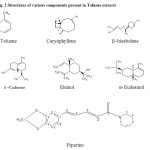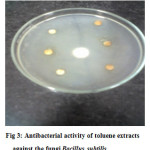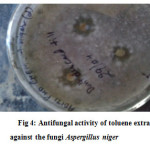In Vitro Antimicrobial and Phytochemical Analysis of Dichloromethane Extracts of Piper nigrum (Black Pepper)
Monika Gupta, Aditi Gupta and Sudhakar Gupta
Department of Chemistry, Lovely Professional University, Phagwara - 144 402, India.
Article Received on :
Article Accepted on :
Article Published : 10 Jun 2013
A variety of alkaloids, terpenoids and other phytochemicals (Formylpiperidine, 4-Terpeneol, Aphellandrene epoxide, Carvacrol, 2-Methyl naphthalene, Piperonal, Dimethoxyphenol, Caryophyllene, 2,4-di-tbutylphenol, β–bisabolene, δ–Cadinene, Elemol, Nerolidol, c-murrolene, α-Eudesmol, Ethyl linoleate etc) have been isolated from the dichloromethane extract of piper nigrum seeds. The components isolated from its oil are meant for aroma. The oil separated from dichloromethane extract was undergone to GC-MS spectroscopy. The components identified by GC-MS spectra, showed that piperonal was present as major component whereas 2- Methyl naphthalene as minor component.
KEYWORDS:GCMS. Gram (+) and Gram (-) bacteria and fungi; Piper nigrum; phytochemical constituents; seed extracts
Download this article as:| Copy the following to cite this article: Gupta M, Gupta A, Gupta S. In Vitro Antimicrobial and Phytochemical Analysis of Dichloromethane Extracts of Piper nigrum (Black Pepper). Orient J Chem 2013;29(2). |
| Copy the following to cite this URL: Gupta M, Gupta A, Gupta S. In Vitro Antimicrobial and Phytochemical Analysis of Dichloromethane Extracts of Piper nigrum (Black Pepper). Available from: http://www.orientjchem.org/?p=11986 |
Introduction
The genus piper, a member of family piperaceae, is an perennial herb, which has over 700 species distributed in both hemispheres. This family has shown a promising effect in therapeutics (Reshmi S.K et al., 2010). Various piper species have been used as spice and in folk medicine due to attributed physiological activities and thus bear a great commercial, economic and medicinal potential (Krishnamurthi A., 1969; Parmar V.S et al., 1997; Kiuchi F et al., 1998; Siddiqui B.S et al., 1997; Nadkarni., 1954).
Black pepper (Piper nigrum L.) “The king of spices” contributes its major share in Indian Spice Export scenario (Zachariah T.J et al., 2010). It is known that piper nigrum has biological activity such as CNS depressant, antioxidant, radical scavenging, anti-insecticidals, antibacterial, allelopathy, anticonvulsant, anti-tubercular, antipyretic, anti-inflammatory, antioxidant and exterofective (C.F.Su, Helen, et al., 1981; Dorman, H.J.D., 2008; Siddiqui, Z.S., 2007; Daniel, M., 2006).
Plant derived substances has obtained greater attention in the recent years to prevent and cure
human diseases as they are considered to be more bio-friendly. It is generally estimated that over
6000 plants in India are in use in traditional, folk, and herbal medicine, representing about 75% medicinal needs of the third world Phyto-chemicals are nonnutritive plant chemicals that have protective or disease preventive properties. Plant produces these chemicals to protect itself but research works demonstrates that many phytochemicals can protect humans against diseases. Knowledge of the chemical constituents of plants is desirable because such information will be of value for the synthesis of complex chemical substances. countries (Veerachari, U et al., 2011).
The main objective of entire study is to perform the complete analysis of various extracts of Piper nigrum to isolate some new compounds.
Experimental
General
The oils were analyzed by using Varian 4000 GC-MS. The instrument operates at the following conditions: equipped with fused silica 30m (CP-Sil-8,Varian) capillary column with an internal diameter of 0.25 mm and a film thickness of 0.25µm, the Helium carrier gas had a delivery rate of 1 ml/min, a capillary injector operating at 280°C in the split mode (1:150),flame ionization detector (FID) running at 300°C, the column oven temperature programming was 50°C for 5 min and then increased from 50 to 250°C at the rate of 3°C/min and hold for 7 min.
Plant material
During our research for novel, bioactive natural products, seeds of Piper nigrum were purchased from an authentic seed shop at Jammu’s district and classified systematically by Dr. Gurdev Singh of the botany department at lovely professional university.
Extraction and Isolation
The dried and crushed seeds (one kg) of Piper nigrum were soxhalated and distilled with different solvents such as light petroleum ether, toluene, dichloromethane, chloroform and methanol according to their polarity gradient. Oily fraction was obtained from dichloromethane extracts after repeated treatment with ethanol. These oily fractions were subjected to GC-MS for identification of components
Analysis of oily fraction
Compounds were identified by their GC retention time relative to known compounds and by comparison of their mass spectra with those present in IIIM library. The GC-MS spectra of the oily fraction of dichloromethane extracts of Piper nigrum unveiled the presence of following components.
Table 1: List of Secondary Metabolites identified in Dichloromethane extracts of Piper nigrum
| Compound number | RT (min) | Compound Name | Area | Amount/Rf |
| 1 | 25.176 | Formylpiperidine | 2658 | 0.446 |
| 2 | 27.230 | 4-Terpeneol | 633 | 0.106 |
| 3 | 28.362 | A-phellandrene epoxide | 1213 | 0.204 |
| 4 | 32.761 | Carvacrol | 1852 | 0.311 |
| 5 | 33.629 | 2-Methyl naphthalene | 618 | 0.104 |
| 6 | 34.732 | Piperonal | 15416 | 2.587 |
| 7 | 35.000 | Dimethoxyphenol | 2359 | 0.396 |
| 8 | 38.367 | Caryophyllene | 3855 | 0.647 |
| 9 | 41.686 | 2,4-di-t-butylphenol | 3216 | 0.540 |
| 10 | 41.832 | β–bisabolene | 1590 | 0.267 |
| 11 | 42.351 | δ –Cadinene | 1359 | 0.228 |
| 12 | 43.573 | Elemol | 3059 | 0.513 |
| 13 | 43.853 | Nerolidol | 992 | 0.166 |
| 14 | 46.763 | 4,4-dimethyl-3-(3-methylbut-3-enylidene)methylenebicyclo[4.1.0] heptane | 2047 | 0.343 |
| 15 | 47.471 | c-murrolene | 6958 | 1.168 |
| 16 | 47.901 | α- Eudesmol | 1436 | 0.241 |
| 17 | 56.881 | Cyclopropanebutanoic acid | 776 | 0.130 |
| 18 | 57.384 | Bicyclo(3.3.1) Nonan-2-one | 1044 | 0.175 |
| 19 | 59.074 | Ethyl palmitate | 1897 | 0.318 |
| 20 | 64.226 | Ethyl linoleate | 1202 | 0.202 |
Table: GC-MS of the various components extracted from the hot dichloromethane extracts of Piper nigrum
 |
Figure 2: Structures of various components isolated from dichloromethane extracts of Piper nigrum. Click here to View figure |
Antimicrobial activity
Cultures
Gram positive bacteria: Bacillus subtilis, Staphylococcus aureus; Gram negative bacteria: Escherichia Coli, Pseudomonas aeruginosa, Salmonella typhi and Fungi Aspergillus niger were obtained from Biotech Research Laboratory, Lovely Professional University.
Chemicals
Nutrient agar and nutrient broth for bacterial cultivation; Potato dextrose agar and potato dextrose broth for fungal cultivation and standard antibiotic like gentamicin were purchased from Hi Media Laboratories Pvt. Ltd., Mumbai.
One gram of the extracts was dissolved in same solvent in such a way that the final concentration of each extract would be 1gm/ml of respective solvent.
Disc diffusion method
The in vitro antimicrobial activity of DCM extracts of pepper were checked by disc diffusion method (Elgavyar, M. et al., 2001). Bacterial culture in log phase was inoculated in nutrient agar and plated. The 5 µl of various extracts were poured on to different discs prepared from whatman No: 1 filter paper. The 2 or 3 discs were then placed on the petriplates containing cultures and incubated bacterias for 24 hours at 37⁰C and fungi in B.O.D incubator for 7 days. The diameter of zone of inhibition was measured.
Table 2: In vitro antibacterial activity of DCM extracts
| Bacterias | Zone of inhibition |
| Gram (+) Bacillus subtilis | (+) 3mm dia |
| Gram (-) Escherichia coli | (-) |
| Gram (-) Pseudomonas aeruginosa | (-) |
| Gram (+) Staphylococcus aureus | (-) |
| Gram (-) Salmonella typhi | (-) |
Table 3: In vitro antifungal activity of DCM extracts
| Fungus | Zone of inhibition |
| Aspergillus niger | (+) 5 mm dia |
 |
Figure 3: Antibacterial activity of DCM extracts against the fungi Bacillus subtilis Click here to View figur |
 |
Figure 4: Antifungal activity of DCM extracts against the fungi Aspergillus niger. Click here to View figure |
Conclusions
Phytochemical screening of DCM extract has shown the presence of large numbers of alkaloids, terpenoids and other organic compounds that are of great importance as a source of new useful drugs. From these studies, it can be concluded that all extracts of Piper nigrum have many beneficial effects with respect to the presence of the above secondary metabolites which are likely to combat many diseases and also boost the immune system. The phytochemical characterization of the extracts, the identification of responsible bioactive compounds and quality standards are necessary for future study.
Acknowledgements
We are very grateful to Dr. Ravikant Khajuria of IIIM, Jammu for GC-MS analysis and Lovely Professional University for lab facility.
References
- Reshmi, S.K., Sathya, E., Devi, S. Isolation of piperidine from Piper nigrum and its antiproliferative activity. J. of Medicinal Plants Research., 2010; 4(15): 1535-1546.
- Krishnamurthi, A. The Wealth of India. Counsil of Scientific and Industrial Research, New Delh,i 1969.
- Parmar, V.S., Jain, S.C., Bisht K.S., Jain, R., Taneja, P., Jha, A., Tyagi, O.D., Prasad, A.K., Wengel, J., Olsen, C.E., Boll, P.M. Phytochemistry of the genus piper. Phytochemistry., 1997; 46: 597-673.
- Kiuchi, F., Nakamura, N., Tsuda, Y., Kondo, K., Yoshimura, H. Amides from Piper nigrum L. with dissimilar effects on melanocyte proliferation in-vitro. Chem.Pharm. Bull., 1998; 36: 2452—2465.
- Siddiqui B. S., Begum S., Gulzar T., Farhat, Noor F. An Amide from fruits of Piper nigrum. Phytochemistry., 1997; 45: 1617—1619.
- Nadkarni, A.K. Indian Materia Medica. Popular Book Depot, Bombay, 1954.
- Zachariah, T.J., Safeer, A.L., Jayarajan, K., Leela, N.K., Vipin, T.M., Saji, K.V., Shiva, K.N., Parthasarathy, V.A., Mammootty, K.P. Correlations of metabolites in the leaf and berries of selected black pepper varieties. Scientia Horticulturae., 2010; 123: 418-422.
- C. F. Su, Helen., Horvat, R. Isolation, Identification and Insecticidals Properties of Piper nigrum Amides. J.Agric.Food.chem., 1981; 29(1): 115-118.
- Dorman, H.J.D., Deans, S.C. Antimicrobial agents from plants: antibacterial activity of plant volatile oils. J.of Applied Microbiology., 2008; 2(88): 308-316.
- Siddiqu, Z.S. Allelopathic effects of black pepper leachings on Vigna mungo(L) Hepper. Acta Physiologiae Plantarum., 2007; 29(4): 303-308.
- Daniel, M. Medicinal Plants: Chemistry and Properties. Science Publisher.USA, 2006.
- Veerachari, U., Bopaiah, A.K. Preliminary phyto-chemical evaluation of the leaf extract of five Cassia Species. J. Chem. Pharm. Res., 2011; 3(5): 574-583.
- Elgavyar, M., Draughon, F.A., Golden, D.A., Mount, J.R. Antimicrobial activity of essential oils from plants against selected pathogenic and saprophytic microorganisms. J Food Prot., 2001; 64(7): 1019-1024.

This work is licensed under a Creative Commons Attribution 4.0 International License.









